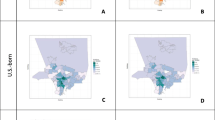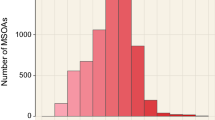Abstract
We present an exploratory analysis of reported county-specific incidence of Lyme disease in the northeastern United States for the years 1990–2000. We briefly review the disease ecology of Lyme disease and the use of risk maps to describe local incidence as estimates of local risk of disease. We place the relevant elements of local environmental and ecological variables, local disease incidence, and (importantly) local disease reporting in a conceptual context to frame our analysis. We then apply hierarchical linear models of increasing complexity to summarize observed patterns in reported incidence, borrowing information across counties to improve local precision. We find areas of increasing incidence in the central northeastern Atlantic coast counties, increasing incidence branching to the north and west, and an area of fairly stable and slightly decreasing reported incidence in western New York.
Similar content being viewed by others
References
Anderson JF, Magnarelli LA (1993) Natural history of Borrelia burgdorferi in vectors and vertebrate hosts, in Ecology and Environmental Management of Lyme Disease, Ginsberg HS (ed) Rutgers University Press, New Brunswick, NJ, pp 11–24
Barbour AG, Fish D (1993) The biological and social phenomenon of Lyme disease. Science 260:1610–1616
Besag JE (1974) Spatial interaction and the statistical analysis of lattice systems (with discussion). J R Stat Soc Ser B 36:741–752
Besag J, Kooperberg C (1995) On conditional and intrinsic autoregressions. Biometrika, 82:733–746
Besag J, York J, Mollié A (1991) Bayesian image restoration with two applications to spatial statistics (with discussion). Ann Ins Stat Math 43:1–59
Besag J, Green P, Higdon D, Mengersen K (1995) Bayesian computation and stochastic systems (with discussion). Stat Sci 10:3–66
Brookmeyer R, Stroup D (2004) Monitoring the health of populations: statistical principles and methods for public health surveillance. Oxford University Press, New York
Buenconsejo J (2004) A Bayesian hierarchical model for estimation of disease incidence using two surveillance datasets. Unpublished Ph.D. Dissertation, Department of Biostatistics and Epidemiology, Yale University
Dennis DT, Nekomoto TS, Victor JC, Paul WS, Piesman J (1998) Reported distribution of Ixodes scapularis and Ixodes pacificus (Acari: Ixodidae) in the United States. J Med Entomol 35:629–638
Dister SW, Fish D, Bros SM, Frank DH, Wood BL (1997) Landscape characterization of peridomestic risk for Lyme disease using satellite imagery. Am J Trop Med Hyg 57:687–692
Donahue JG, Piesman J, Speilman J (1997) Reservoir competence of white-footed mice for Lyme disease spirochetes. Am J Trop Med Hyg 36:92–96
Duffy DC, Campbell SR, Clark D, Dimotta C, Gurney S (1994) Ixodes scapularis (Acari: Ixodidae) deer tick mesoscale populations in natural areas: effects of deer, area, and location. J Med Entomol 31:152–158
Estrada-Pena A (1998) Geostatistics and remote sensing as predictive tools of tick distribution: a cokriging system to estimate Ixodes scapularis (Acari: Ixodidae) habitat suitability in the United States and Canada from advanced very high resolution radiometer satellite imagery. J Med Entomol 35:989–995
Fish D (1993) Population ecology of Ixodes dammini. In: Ginsberg H.S. (eds). Ecology and environmental management of Lyme disease. Rutgers University Press, New Brunswick, NJ, pp 25–42
Frank C, Fix AD, Pena CA, Strickland GT (2002) Mapping Lyme disease incidence for diagnostic and preventive decisions, Maryland. Emerg Infect Dis 8:427–429
Giardina AR, Schmidt KA, Schauber EM, Ostfeld RS (2000) Modeling the role of songbirds and rodents in the ecology of Lyme disease. Can J Zool 78:2184–2197
Ginsberg HS, Ewing CP (1989) Habitat distribution of Ixodes dammini (Acari: Ixodidae) and Lyme disease spirochetes on Fire Island, NY. J Med Entomol 26:183–189
Glass GE, Amerasinghe FP, Morgan JM, Scott TW (1994) Predicting Ixodes scapularis abundance on white-tailed deer using geographic information systems. Am J Trop Med Hyg 51:538–544
Glass GE, Schwartz BS, Morgan JM, Johnson DT, Noy PM, Israel E (1995) Environmental risk-factors for Lyme disease identified with geographic information systems. Am J Public Health 85:944–948
Goodwin BJ, Ostfeld RS, Schauber EM (2001) Spatiotemporal variation in a Lyme disease host and vector: blacklegged ticks on white-footed mice. Vector Borne Zoonotic Dis 1:129–138
Kelsall J, Wakefield J (1999) Discussion of “Bayesian models for spatially correlated disease and exposure data.” In: Best NG Arnold RA, Thomas A, Conlon E, Waller LA in Bayesian Statistics 6, Bernardo JM, Berger JO, Dawid AP, Smith AFM (eds) Oxford University Press, Oxford, p 151
Keirans JE, Hutcheson HJ, Durden LA, Klompen JSH (1996) Ixodes (Ixodes) scapularis (Acari: Ixodidae): redescription of all active stages, distribution, hosts, geographical variation, and medical and veterinary importance. J Med Entomol 33:297–318
Kitron U (2000) Risk maps: transmission and burden of vector-borne diseases. Parasitol Today 16: 324–325
Kitron U, Bouseman JK, Jones CJ (1991) Use of the ARC/INFO GIS to study the distribution of Lyme disease in an Illinois county. Prev Vet Med 11:243–248
Kitron U, Jones CJ, Bouseman JK, Nelson JA, Baumgartner DL (1992) Spatial analysis of the distribution of Ixodes dammini (Acari: Ixodidae) on white tailed deer in Ogle County, IL. J Med Entomol 29:259–266
Kitron U, Kazmierczak JJ (1997) Spatial analysis of the distribution of Lyme disease in Wisconsin. Am J Epidemiol 145:558–566
Knorr-Held L, Besag J (1998) Modelling the risk of a disease in time and space. Stat Med 17:2045–2060
Lane RS, Piesman J, Burgdorfer W (1991) Lyme borreliosis: relation of its causative agent to its vectors and hosts in North America and Europe. Ann Rev Entomol 36:587–609
Levine JF, Wilson ML, Speilman A (1985) Mice as reservoirs of the Lyme disease spirochete. Am J Trop Med Hyg 34:355–360
Mather TN (1993) The dynamics of spirochete transmission between ticks and vertebrates. In: Ginsberg HS (eds). Ecology and environmental management of Lyme disease. Rutgers University Press, New Brunswick, NJ, pp 43–62
Mather TN, Ginsberg HS (1994) Vector-host-pathogen relationships: transmission dynamics of tick-borne infections. In: Sonenshine DE, Mather TN (eds). Ecological dynamics of tick-borne zoonoses. Oxford University Press, NY, pp 68–90
Mather TN, Wilson ML, Moore SI, Ribeiro JMC, Spielman A (1989) Comparing the relative potential of rodents as reservoirs of the Lyme disease spirochete (Borrelia burgdorferi). Am J Epidemiol 130:143–150
Naleway AL, Belongia EA, Kazmierczak JJ, Greenlee RT, Davis JP (2002) Lyme disease incidence in Wisconsin: a comparison of state-reported rates and rates from a population-based cohort. Am J Epidemiol 155:1120–1127
Orloski KA, Campbell GL, Genese CA, Beckley JW, Schriefer ME, Spitalny KC, Dennis DT (1998) Emergence of Lyme disease in Hunterdon County, NJ, 1993: a case-control study of risk factors and evaluation of reporting patterns. Am J Epidemiol 147:391–397
Orloski KA, Hayes EB, Campbell GL, Dennis DT (2000) Surveillance for Lyme disease—United States, 1992–1998. Morb Mortal Wkly Rep (Surveillance Summaries) 49:1–11
Patrican LA (1997) Absence of Lyme disease spirochetes in larval progeny of naturally infected Ixodes scapularis (Acari: Ixodidae) fed on dogs. J Med Entomol 34:52–55
Piesman J, Spielman A (1979) Host-associations and seasonal abundance of immature Ixodes dammini in southeastern Massachusetts. Ann Entomol Soc Am 72:829–832
Piesman J, Donahue JG, Mather TN, Spielman A (1986) Transovarially acquired Lyme disease spirochetes (Borrelia burgdorferi) in field-collected larval Ixodes dammini (Acari: Ixodidae). J Med Entomol 23:219
Schmid GP, Horsley R, Steere AC, Hanrahan JP, Davis JP, Bowen GS, Osterholm MT, Weisfeld JS, Hightower AW, Broome CV (1985) Surveillance of Lyme disease in the United States, 1982. J Infect Dis 151:144–1149
Schootman M, Sun D (2004) Small-area incidence trends in breast cancer. Epidemiology 15:300–307
Scrimenti RJ (1970) Erythema chronicum migrans. Arch Dermatol 102:104–105
Steere AC, Malawista SE, Snydman DR, Shope RE, Andiman WA, Ross MR, Steele FM (1977) Lyme arthritis: an epidemic of oligoarticular arthritis in children and adults in three connecticut communities. Arthritis Rheum 20:7–17
Teutsch SM, Churchill RE (1994) Principles and practice of public health surveillance. Oxford University Press, New York
US CDC (2001). Lyme Disease—United States, 1999. Morb Mortal Wkly Rep 50:181–185
van Buskirk J, Ostfeld RS (1995) Controlling Lyme disease by modifying the density and species composition of tick hosts. Ecol Appl 5:1133–1140
Wakefield JC, Best NG, Waller L (2000) Bayesian approaches to disease mapping. In: Elliott P, Wakefield JC, Best NG, Briggs DG (eds). Spatial epidemiology: methods and applications. Oxford University Press, Oxford, pp 104–127
Waller LA, Gotway CA (2004) Applied spatial statistics for public health data. Wiley, New York
White DJ, Chang H-G, Benach JL, Bosler EM, Meldrum SC, Means RG, Debbie JG, Birkhead GS, Morse DL (1991) The geographic spread and temporal increase of the Lyme disease epidemic. J Am Med Assoc 266:1230–1236
Wilson ML (1998) Distribution and abundance of Ixodes scapularis (Acari: Ixodidae) in North America: ecological processes and spatial analysis. J Med Entomol 35:446–457
Wilson ML, Ducey AM, Litwin TS, Gavin TA, Spielman A (1990) Microgeographic distribution of immature Ixodes dammini ticks correlated with that of deer. Med Vet Entomol 4:151–159
Author information
Authors and Affiliations
Corresponding author
Rights and permissions
About this article
Cite this article
Waller, L.A., Goodwin, B.J., Wilson, M.L. et al. Spatio-temporal patterns in county-level incidence and reporting of Lyme disease in the northeastern United States, 1990–2000. Environ Ecol Stat 14, 83–100 (2007). https://doi.org/10.1007/s10651-006-0002-z
Received:
Revised:
Published:
Issue Date:
DOI: https://doi.org/10.1007/s10651-006-0002-z




